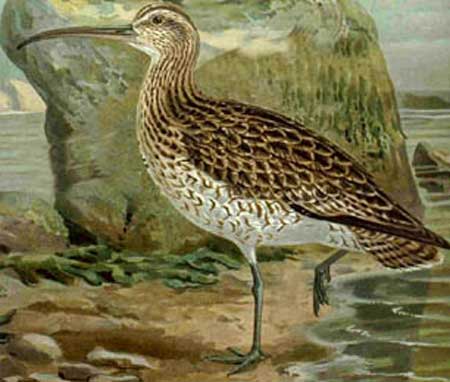Numenius phaeopus (*) Cladus: Eukaryota Name Numenius phaeopus (Linnaeus, 1758) Reference Systema Naturae ed.10 p.146 Vernacular names The Whimbrel Numenius phaeopus, is a wader in the large family Scolopacidae. It is the one of the most widespread of the curlews, breeding across much of subarctic North America, Europe and Asia as far south as Scotland. This is a migratory species wintering on coasts in Africa, South America, south Asia into Australasia and southern North America. It is also a coastal bird during migration.[1] It is fairly gregarious outside the breeding season. Description This is a large wader at 37–45 centimetres (15–18 in) length. It is mainly greyish brown, with a white back and rump (subspecies N. p. phaeopus and N. p. alboaxillaris only), and a long curved bill (longest in the adult female) with a kink rather than a smooth curve. It is generally wary. The usual call is a rippling whistle, prolonged into a trill for the song. The only similar common species over most of this bird's range are larger curlews. The Whimbrel is smaller, has a shorter, decurved bill and has a central crown stripe and strong supercilia. Subspecies There are four subspecies: * Numenius phaeopus phaeopus - northern Europe, northwestern Asia
This species feeds by probing soft mud for small invertebrates and by picking small crabs and similar prey off the surface. Prior to migration, berries become an important part of their diet. It also eats blue butterflies [see references]. The nest is a bare scrape on tundra or Arctic moorland. Three to five eggs are laid. Adults are very defensive of nesting area and will even attack humans who come too close. Near the end of the 19th century, hunting on their migration routes took a heavy toll on this bird's numbers; the population has since recovered. In the British Isles it breeds in Scotland, particularly around Shetland, Orkney, the Outer Hebrides as well as the mainland at Sutherland and Caithness. The Whimbrel is one of the species to which the Agreement on the Conservation of African-Eurasian Migratory Waterbirds (AEWA) applies. References 1. ^ "Birds" (Collins Pocket Guide 1998), p.156. * BirdLife International (2004). Numenius phaeopus. 2006. IUCN Red List of Threatened Species. IUCN 2006. www.iucnredlist.org. Retrieved on 11 May 2006. Database entry includes justification for why this species is of least concern Source: Wikipedia, Wikispecies: All text is available under the terms of the GNU Free Documentation License |
|

